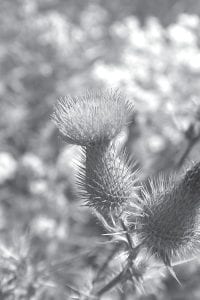Although the Canada thistle (Cirsium arvense) makes a lovely picture when it flowers, it is an aggressive, perennial weed that infests yards, trails and roadsides. The Minnesota Department of Natural Resources has launched a new campaign “PlayCleanGo: Stop Invasive Species in Your Tracks” to try to stop the spread of such bothersome plants.

Minnesota’s terrestrial (land-based) invasive species outreach program known as, “PlayCleanGo: Stop Invasive Species in Your Tracks” is kicking off a new campaign, according to the Minnesota Department of Natural Resources (DNR).
“The campaign aims to do two things: encourage outdoor recreation on Minnesota trails, parks and recreation sites and to educate and create awareness among outdoor recreationists about terrestrial invasive species,” said Sue Burks, DNR’s forestry invasive species coordinator.
A variety of media, including handouts, social media, online advertising, email marketing and events will be used. The program will also continue to partner with government agencies, community groups and retail stores to further educate the public. Campaign themes include “Give Invasive Species the Brush Off” and “Wipe ‘em Off. Wipe ‘em Out!”
“PlayCleanGo” encourages outdoor recreation such as offhighway vehicle riding, hiking, biking and horseback riding on Minnesota trails, parks and recreation sites while following a few simple steps to help stop the spread of terrestrial invasive species.
The campaign was developed in response to the increased emergence of terrestrial invasive species, which are land-based plants, animals and micro-organisms that are not native to a particular area. They are also species that are capable of causing severe damage in areas outside their normal range, harming the economy, the environment or human health once they become established. The term “invasive” is reserved for the most aggressive nonnative species capable of changing sites or living conditions for the worse where they establish.
According to Burks, a few of the common invasive species found on land include earthworms, Canada thistle, common buckthorn, wild parsnip and the two fungal species that cause Dutch elm disease and oak wilt. Emerald ash borer is a terrestrial invasive species relatively new to the state that has the public concerned about the health of their ash trees.
The “PlayCleanGo” program is a joint effort of interagency and community partners including the U.S. Forest Service, University of Minnesota Extension, Minnesota Departments of Agriculture and Transportation, Explore Minnesota and the Minnesota Department of Natural Resources.
Visit www.playcleango.org for more information on stopping the spread of terrestrial invasive species and how to become a partner.
Steps to slow the spread of invasive species
. Arrive with clean
gear.
. Burn local or
certified firewood.
. Use local or weedfree hay.
. Stay on the trails.
. Before leaving,
remove mud and
seeds.


Loading Comments